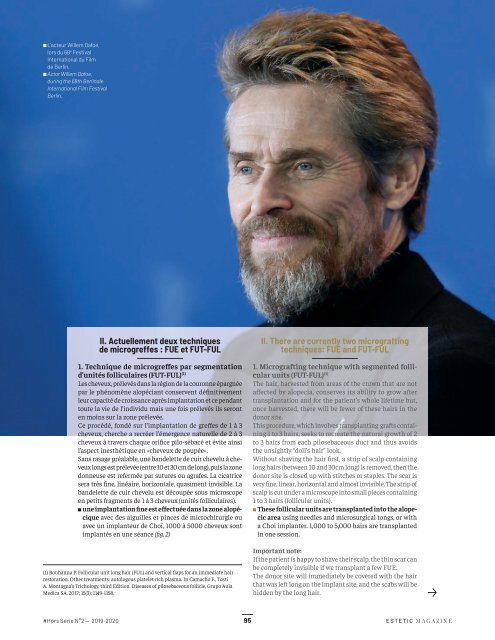ESTETIC 2019
You also want an ePaper? Increase the reach of your titles
YUMPU automatically turns print PDFs into web optimized ePapers that Google loves.
L’acteur Willem Dafoe,<br />
lors du 68 e Festival<br />
International du Film<br />
de Berlin.<br />
Actor Willem Dafoe,<br />
during the 68th Berlinale<br />
International Film Festival<br />
Berlin.<br />
II. Actuellement deux techniques<br />
de microgreffes : FUE et FUT-FUL<br />
1. Technique de microgreffes par segmentation<br />
d’unités folliculaires (FUT-FUL) (1)<br />
Les cheveux, prélevés dans la région de la couronne épargnée<br />
par le phénomène alopéciant conservent définitivement<br />
leur capacité de croissance après implantation et ce pendant<br />
toute la vie de l’individu mais une fois prélevés ils seront<br />
en moins sur la zone prélevée.<br />
Ce procédé, fondé sur l’implantation de greffes de 1 à 3<br />
cheveux, cherche a recréer l’émergence naturelle de 2 à 3<br />
cheveux à travers chaque orifice pilo-sébacé et évite ainsi<br />
l’aspect inesthétique en «cheveux de poupée».<br />
Sans rasage préalable, une bandelette de cuir chevelu à cheveux<br />
longs est prélevée (entre 10 et 30 cm de long), puis la zone<br />
donneuse est refermée par sutures ou agrafes. La cicatrice<br />
sera très fine, linéaire, horizontale, quasiment invisible. La<br />
bandelette de cuir chevelu est découpée sous microscope<br />
en petits fragments de 1 à 3 cheveux (unités folliculaires).<br />
une implantation fine est effectuée dans la zone alopécique<br />
avec des aiguilles et pinces de microchirurgie ou<br />
avec un implanteur de Choï, 1000 à 5000 cheveux sont<br />
implantés en une séance (fig. 2)<br />
(1) Bouhanna P. Follicular unit long hair (FUL) and vertical flaps for an immediate hair<br />
restoration. Other treatments: autologous platelet rich plasma. In Camacho F., Tosti<br />
A. Montagna’s Trichology, third Edition. Diseases of pilosebaceous follicle, Grupo Aula<br />
Medica SA, 2017; 15(3): 1149-1158.<br />
II. There are currently two micrografting<br />
techniques: FUE and FUT-FUL<br />
1. Micrografting technique with segmented follicular<br />
units (FUT-FUL) (1)<br />
The hair, harvested from areas of the crown that are not<br />
affected by alopecia, conserves its ability to grow after<br />
transplantation and for the patient’s whole lifetime but,<br />
once harvested, there will be fewer of these hairs in the<br />
donor site.<br />
This procedure, which involves transplanting grafts containing<br />
1 to 3 hairs, seeks to recreate the natural growth of 2<br />
to 3 hairs from each pilosebaceous duct and thus avoids<br />
the unsightly “doll’s hair” look.<br />
Without shaving the hair first, a strip of scalp containing<br />
long hairs (between 10 and 30cm long) is removed, then the<br />
donor site is closed up with stitches or staples. The scar is<br />
very fine, linear, horizontal and almost invisible. The strip of<br />
scalp is cut under a microscope into small pieces containing<br />
1 to 3 hairs (follicular units).<br />
These follicular units are transplanted into the alopecic<br />
area using needles and microsurgical tongs, or with<br />
a Choi implanter. 1,000 to 5,000 hairs are transplanted<br />
in one session.<br />
Important note:<br />
If the patient is happy to shave their scalp, the thin scar can<br />
be completely invisible if we transplant a few FUE.<br />
The donor site will immediately be covered with the hair<br />
that was left long on the implant site, and the scabs will be<br />
hidden by the long hair.<br />
#Hors Série N°2 — <strong>2019</strong>-2020<br />
95 <strong>ESTETIC</strong> MAGAZINE

















